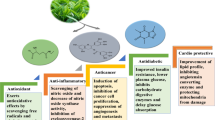We designed a new complex drug with antiallergic effect containing, in addition to the main component loratadine, a phytocomplex for an extra therapeutic effect. A collection of plants with sedative activity is chosen and the optimal agent for extraction of bioactive compounds (40% ethanol) and optimal degree of plant fragmentation are determined. Chemical composition of the sedative tea is evaluated by reverse phase HPLC. The marker components of the species are detected: xanthohumol and isoxanthohumol — Humulus lupulus cone components, Mentha piperita rosmarinic acid, and scutellareine, Menyanthes trifolia element — quercetin-3-rutinoside, and caffeic acid. Standardization of the species by the absolute graduation method in conversion to quercetin-3-rutinoside is suggested.
Similar content being viewed by others
References
Alekseeva MA, Eller KI, Arzamastsev AP. Determination of prenylated flavonoids of hops and phytopreparations based on this plant by reverse phase HPLC. Vopr. Biol., Med. Farm. Khimii. 2004;2(3):45-48. Russian.
Bystrova MN, Demidova MA, Panina GA, Zholobov IS, Galchinskaya IL. The influence of sedative gathering preparations on roughly-research behaviour of mice. Sovremen. Problemy Nauki Obrazovaniya. 2011;(6):16. Russian.
Bystrova MN, Panina GA, Demidova MA, Kharitonova EV. Comparative study of the flavonoid content in preparations of sedative collection No. 3. Traditsionnaya Meditsina. 2011;(5):174-177. Russian.
Zhilyakova ET, Novikov OO, Novikova OYu. Target Mechanoactivation of Pharmaceutical Substances. Saarbrücken, 2012. Russian.
Levin YaI, Kovrov GV. Antihistamine preparations and sedation. Allergologiya. 2002;(3):38-41. Russian.
Novikov OO, Pisarev DI, Zhilyakova ET, Novikova MY, Pisareva NA, Voronkova OS, Bezmenova MD. Using the matrixassisted laser desorption ionization for the analysis of flavonoid glycosides in objects of plant origin. Bull. Exp. Biol. Med. 2013;154(3):399-402.
Dávila I, Sastre J, Bartra J, del Cuvillo A, Jáuregui I, Montoro J, Mullol J, Valero A.L. Effect of H1 antihistamines upon the cardiovascular system. J. Investig. Allergol. Clin. Immunol. 2006;16(Suppl. 1):13-23.
del Cuvillo A, Mullol J, Bartra J, Dávila I, Jáuregui I, Montoro J, Sastre J, Valero A.L. Comparative pharmacology of the H1 antihistamines. J. Investig. Allergol. Clin. Immunol. 2006;16(Suppl. 1):3-12.
Ciprandi G, Catrullo A, Cerqueti P, Tosca M, Fiorino N, Canonica GW. Loratadine reduces the expression of ICAM-1. Allergy. 1998;53(5):545-546.
Author information
Authors and Affiliations
Corresponding author
Additional information
Translated from Byulleten’ Eksperimental’noi Biologii i Meditsiny, Vol. 163, No. 6, pp. 718-721, June, 2017
Rights and permissions
About this article
Cite this article
Kulikovskii, V.F., Zhilyakova, E.T., Novikov, O.O. et al. Study of Sedative Tea Phytocomplex within the Framework of Studies Aimed at Creation of a Rectal Dosage Form with Antihistaminic Effect. Bull Exp Biol Med 163, 753–756 (2017). https://doi.org/10.1007/s10517-017-3896-6
Received:
Published:
Issue Date:
DOI: https://doi.org/10.1007/s10517-017-3896-6



